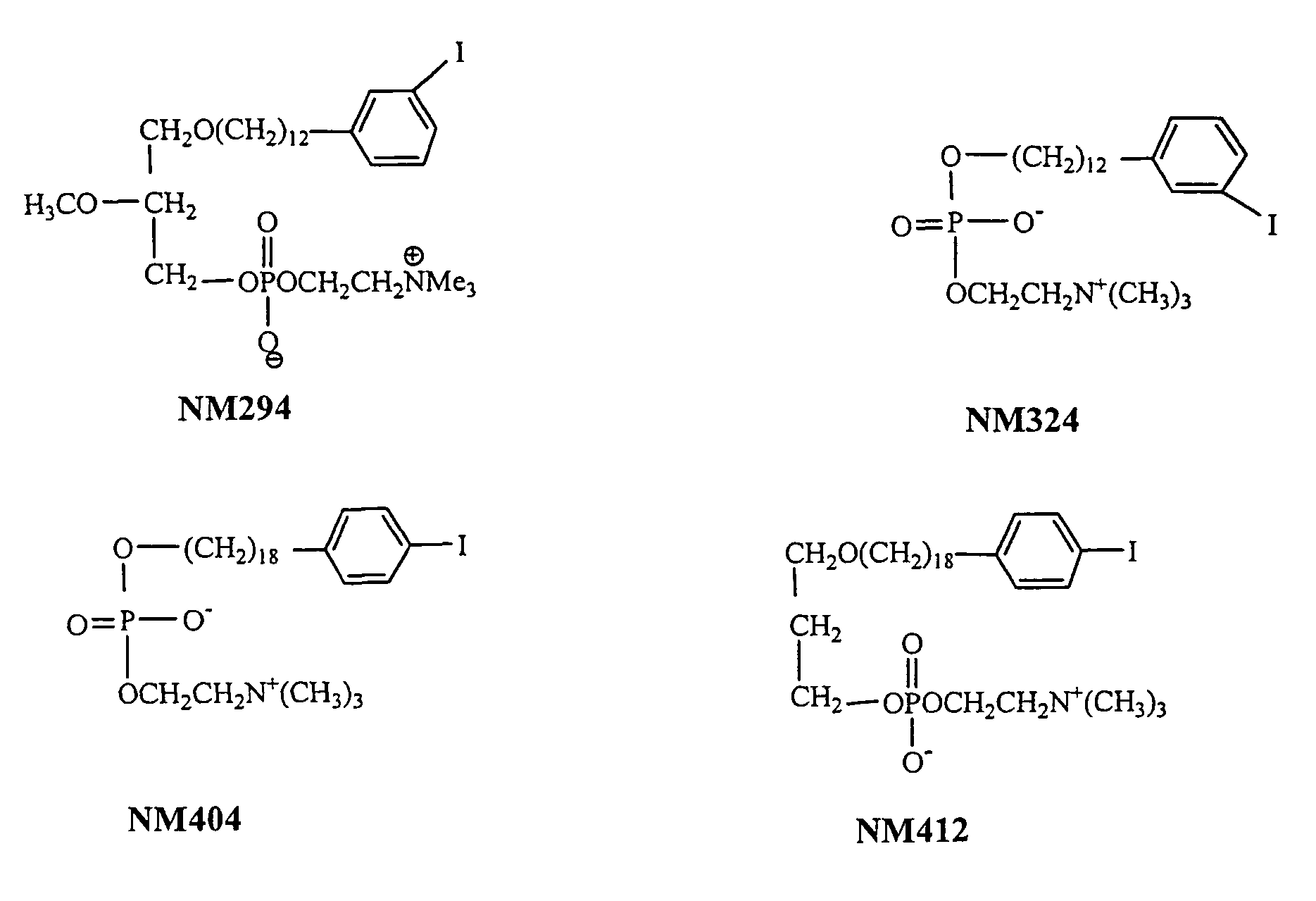Method for the synthesis of phospholipid ethers
a technology of phospholipid ether and ether, which is applied in the field of synthesis of phospholipid ether analogs, can solve the problems of limited versatility, ineffective dose levels, and ple compounds, and achieves greater ease of separation and purity of products, greater versatility of reactants used, and greater ease of synthesizing.
- Summary
- Abstract
- Description
- Claims
- Application Information
AI Technical Summary
Benefits of technology
Problems solved by technology
Method used
Image
Examples
example 1
Improved Synthesis of Long Chain ω-(p-Iodophenyl)alkyl Alcohols and Corresponding Phospholipid Ethers and Alkyl Phosphocholines Including NM404
[0060]The catalyst (Formula III) is a Ni(II) complex of 2,6-bis-(4-isopropyl-2-oxazolin-2-yl)-pyridine (1-Pr-Pybox) 71 or 2,6-bis-(4-sec-butyl-2-oxazolin-2-yl)-pyridine (s-Bu-Pybox) 72 or 2,6-bis-(4-phenyl-2-oxazolin-2-yl)-pyridine (Ph-Pybox) 73 or pybox (H-Pybox) 74 or 2,6-bis-(4-phenylethyl-2-oxazolin-2-yl)-pyridine (BnCH2-Pybox) 75. The cross-coupling reaction can be performed at 0° C. or room temperature.
[0061]
In some preferred embodiments, the invention includes an intermediate in the synthesis having the structure shown in formula V:
[0062]
In this embodiment, M is selected from the group consisting of Li, Na, K, Cs and Rb.
[0063]This method allows to synthesize 18-(p-iodophenyl)octadecanol 12 from various commercial precursors. One approach is shown in Scheme I. In the first step, organozinc reagent 33 obtained from 11-bromoundecyl acetat...
example 2
Cross-Coupling of Alkyl Zinc Reagents with Alkyl Halides
[0100]In the synthetic scheme illustrated in SCHEME V, the inventors disclose the synthesis of PLEs based on cross-coupling of alkyl zinc reagents with alkyl halides catalyzed by Ni(II)-i-Pr-Pybox and / or Pd-PEPPSI-IPr complexes. Reaction conditions were optimized for various combinations of alkyl halides and organozinc reagents allowing the production of desired PLE analogs in multigram quantities. In these reactions, the chain elongation sequence can be abbreviated as C6+C11+PhC1=IPHC18
[0101]
[0102]Methods
[0103]Synthesis of Tetrahydro-2-(17-acetoxyheptadecyloxy)-2H-pyran (39).
[0104]In a 50-ml flask, zinc powder (98 mg, 1.5 mmol) was dried at 70° C. under high vacuum for 30 min. After back-filling with nitrogen, DMI (25 ml) was added followed by solid I2 (380 mg, 1.53 mmol) for Zn activation. The iodine color disappeared after stirring for 5 min. Neat 6-bromohexyl acetate (6.83 g, 30.61 mmol) was added and the mixture was stirre...
example 3
Attachment of the p-Iodophenyl Group
[0107]As discussed above, when they PLE synthesis method proceeds via a chain elongation process summarized as: IPhC1+C11+C6=IPhC18, C6+C11+IPhC1=IPhC18, or C16+IPhC2=IPhC18. The process is followed by attachment of the p-iodophenyl group as shown in SCHEME VI and VII and further illustrated in FIG. 7.
[0108]
[0109]
[0110]Another combination of alkyl halides and organozinc reagents is shown in Scheme VIII.
[0111]
[0112]Methods
[0113]Synthesis of Ethyl 17-(tetrahydropyran-2-yl-oxy)-heptadecanoate (78).
[0114]Method 1. From (38) and (76). Zinc powder (166 mg, 2.55 mmol) was dried at 70° C. for 30 min in a sealed tube, then DMA (2.5 ml) and solid 12 (22 mg, 0.09 mmol) were added. After stirring for 10 min, neat ethyl 11-bromoundecanoate (500 mg, 1.7 mmol) was added and the reaction mixture was stirred in the sealed tube for 10 h at 80° C. In a 10-ml flask, NiCl2-glyme (29 mg, 0.13 mmol) and (R)-(i-Pr)-Pybox (or (S)-(i-Pr)-Pybox) (51 mg, 0.17 mmol) were diss...
PUM
| Property | Measurement | Unit |
|---|---|---|
| temperature | aaaaa | aaaaa |
| temperature | aaaaa | aaaaa |
| temperature | aaaaa | aaaaa |
Abstract
Description
Claims
Application Information
 Login to View More
Login to View More - R&D
- Intellectual Property
- Life Sciences
- Materials
- Tech Scout
- Unparalleled Data Quality
- Higher Quality Content
- 60% Fewer Hallucinations
Browse by: Latest US Patents, China's latest patents, Technical Efficacy Thesaurus, Application Domain, Technology Topic, Popular Technical Reports.
© 2025 PatSnap. All rights reserved.Legal|Privacy policy|Modern Slavery Act Transparency Statement|Sitemap|About US| Contact US: help@patsnap.com



